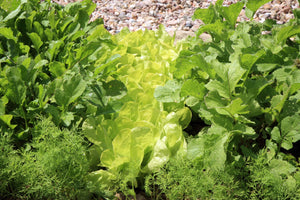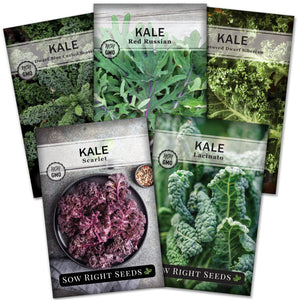Topics
Turnips vs Rutabagas vs Parsnips? Easy Steps to Grow all 3 from Seed
Turnips, rutabagas, and parsnips are healthy root vegetables that don’t appear on many kitchen tables, but they should. When grown and harvested correctly, they have an enjoyable flavor and are packed with vitamins and minerals. Now is the time to add these heirloom vegetables to your garden.

Easy Steps to Grow Rutabaga, Turnips, and Parsnips
Parsnips, rutabagas, and turnips are all excellent cool-weather crops. They are easy to grow and thrive in temperatures between 40 to 80ºF. Although they each have their own individual characteristics, these basic steps will help you grow them successfully from seed.
1 - Prepare the soil
2 - Sow the seeds
3 - Thin the seedlings
4 - Water the roots
5 - Harvest the vegetables
What’s the difference between Turnips, Rutabaga, and Parsnips?
So, what’s the difference between these cool-weather crops? One way I like to distinguish the difference is to think about what vegetables they can be substituted for. Rutabagas can be substituted for potatoes, parsnips can be used in place of carrots, and turnips can be used in place of radishes.
You'll easily distinguish between these three root vegetables once you get to know them.
Turnips Vs. Rutabagas
Turnips and rutabagas are both in the brassica family.
Rutabaga is brassica napus and is a cross between cabbage and turnips.
Rutabagas are harder than turnips and need to be cooked. Turnips can be eaten raw.
Rutabagas are a little more yellow inside than turnips and have a sweeter flavor.
Parsnips Vs. Turnips
Parsnips have a long root like carrots while turnips are round like radishes.
Parsnips are sweeter than turnips, with a hint of licorice taste.
Parsnips are in the same family as carrots, while turnips are in the same family as cabbage. That gives you an idea of their taste and how they can be used.
Rutabagas Vs. Parsnips
Rutabagas are rounded, and parsnips are long and slender.
Rutabaga can be substituted for potatoes, and parsnip can be used in place of carrots. (A stew with these two makes a beautiful and delicious combination.)

1 - Preparing the Soil
The best soil for growing rutabagas, turnips, and parsnips is loose, fertile soil. The roots need freedom to spread as they grow. Raised beds are a great place to grow root vegetables.
You can add a balanced fertilizer before planting. Too much nitrogen can result in branching roots and excess foliage. You don’t want to encourage too much leaf growth unless you are growing them only to harvest the greens. Otherwise, you want the roots to reach deep and develop to a harvestable size.
Well-rotted compost is an excellent soil addition for growing root vegetables. It will give you fertile soil that retains moisture without being waterlogged.
2 - Planting Turnip, Rutabaga, and Parsnip Seeds
All three of these root vegetables can be directly sown into the garden. Transplanting seedlings with long tap roots can disturb their growth.
The seeds can germinate in a wide range of temperatures from 40 to 100ºF, but the smaller range of 55 to 75ºF is optimal.
Growing these three root vegetables is similar enough that they can be put together. But there are a few differences that we will point out.
These vegetables like full sun but cooler temperatures ranging from 40 to 75ºF.
Some gardeners prefer planting them in summer for a fall harvest. This often results in a sweeter taste when they have a light frost.
Rutabagas can take twice the time as turnips to mature. So keep that in mind when planning when to sow seeds. Turnips can be sown 2 to 3 weeks before the last spring frost date.
Tips for fail-proof parsnip, turnip, and rutabaga seed germination.
Direct sow - root vegetables don’t transplant well.
Plant seeds ½” deep.
Soil temperature - 55 to 75ºF.
Germinate in 6 to 10 days. (Parsnips take 14 to 21 days)

3 - Thinning the Seedlings
Root vegetables need room to grow underground, so it is important to thin the seedlings to give them enough space.
Thin rutabaga and turnip seedlings when they are 3 to 4 inches tall. (Parsnips 2” tall.) Space rutabaga 3 to 6 inches apart, turnips 6 to 8, and parsnips 3 inches.
When thinning seedlings, use scissors and cut instead of pulling. You can eat cut seedlings as microgreens and avoid disturbing the remaining plants.
You can succession sow every two weeks for a staggered harvest.
Snowball Turnip
The Snowball Turnip is a fast-growing variety. It produces tender snow-white roots that are beautifully round.
4 - Watering the Roots
For rutabagas, turnips, and parsnips, consistent water is vital for the best flavor and texture. Soaker hoses and drip irrigation are excellent ways to keep the soil moist.
Consistent water will avoid drought stress, which leads to bitter and tough roots.
The addition of mulch can help keep the soil moist and prevent weeds from growing.
Follow these tips to keep the root vegetables free from stress so that they develop good bulbs and don’t go to seed or bolt.
American Purple Top Rutabaga
Harvesting Rutabaga
Harvest rutabagas when they are 3 to 5 inches in diameter. Larger ones may look impressive, but the flavor and texture will be better with smaller bulbs.
You may need to use a spading fork instead of pulling to get rutabagas out of the ground.
Harvesting Parsnips
Parsnips are ready to harvest when they are 2 to 4 inches in diameter. If growing them in the fall, you can wait until they’ve had a light frost, which gives them a sweeter taste.
Use a spading fork to help dislodge the long taproots.

Half Long White Parsnip
This classic parsnip is a German heirloom, also known as Halblange Weisse. It has 10-inch long tapering roots with a sweet, anise-like flavor. This easy-to-grow root vegetable is easy to harvest and stores well.
Harvesting Turnips
Turnips need to be harvested before the summer heat kicks in. When temperatures start getting into the 80s, it’s time to pull them out of the ground.
In the fall, you can harvest after a light frost but before a freeze. This gives them a sweeter taste. To protect them from freezing, add two or more inches of mulch.
Turnip greens can be harvested as soon as they are several inches long. But don’t remove all of them if you want to harvest the roots later. Harvest the greens when they are young, as older leaves will be more bitter.
Storing
Remove leaves before storing root vegetables. Keep them dry and loosely wrapped in plastic so they don’t dry out.
Try roasting these cool-weather vegetables for a delicious flavor. Coat them in olive oil and fresh rosemary.

Purple Top Turnip
Purple Top Turnip grows smooth round globes that are purple on top and white below the soil line. This variety is excellent for its edible greens. Purple Top Turnips have a fine-grained texture and sweet flavor that can be enjoyed raw or cooked. They are best when harvested around 3" in diameter.

FAQs
When should I plant rutabagas?
Rutabagas grow well in cool temperatures, which makes fall an excellent time to plant seeds. Depending on your growing zone you will want to have them maturing in the cool temperatures of fall when they will receive a light frost.
Why are my rutabagas woody?
Stress from insufficient water can make rutabaga turn bitter and woody. Make sure they are receiving at least 1 inch of water a week. More may be needed depending on how well the soil retains moisture.
Can you grow turnips in containers?
Turnips can be grown in containers as long as they have moist soil and room to grow. About 12 inches deep.
Spring and fall are the perfect time to sow cool-weather vegetables. Rutabagas, turnips, and parsnips are easy to grow and delicious. It’s time to sow seeds!







Leave a comment